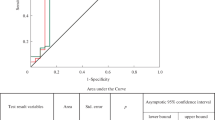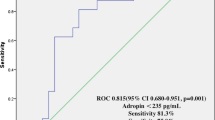Abstract
Background
Apnea-related hypoxia, hypercapnia, and blood pressure fluctuations cause production of various proinflammatory cytokines and trigger a vicious cycle that results in vascular endothelial damage and systemic inflammation in obstructive sleep apnea (OSA). Endothelial function is frequently impaired in OSA even in the absence of significant cardiac or vascular disorders.
Aims
This study aimed to investigate the serum endocan and serglycin levels in OSA patients.
Methods
This prospective study included 78 consecutive patients who admitted to the sleep laboratory of a tertiary referral center with the complaints of daytime sleepiness, witnessed sleep apnea, and/or snoring and who underwent all-night polysomnography (PSG). After PSG, the patients were divided into four groups in relation with their apnea–hypopnea indexes. The groups were compared for endocan and serglycin levels and their correlations with OSA severity. The correlations with demographic data and PSG findings were also investigated.
Results
The OSA and the control groups had significantly different endocan and serglycin levels (\(p = 0.001\), for both). On univariate logistic regression analysis, it was found that serglycin and endocan levels and BMI were predictors of OSA. Multiple logistic regression analysis showed that endocan and serglycin levels were independent predictors for OSA (\(p = 0.027\) and \(p = 0.003\), respectively).
Conclusions
We have demonstrated that elevated endocan and serglycin levels are predictors for OSA. Furthermore, we have showed for the first time in literature that serglycin is correlated with OSA and is an independent predictor for OSA.




Similar content being viewed by others
Data availability
The datasets used and/or analyzed during the current study are available from the corresponding author on reasonable request.
References
Young T, Palta M, Dempsey J et al (2009) Burden of sleep apnea: rationale, design, and major findings of the Wisconsin Sleep Cohort study. WMJ 108(5):246–249
Peppard PE, Young T, Barnet JH et al (2013) Increased prevalence of sleep-disordered breathing in adults. Am J Epidemiol 177(9):1006–1014. https://doi.org/10.1093/aje/kws342
Lee S, Thomas RJ, Kim H et al (2014) Association between high nocturnal blood pressure and white matter change and its interaction by obstructive sleep apnoea among normotensive adults. J Hypertens 32(10):2005–2012; discussion 2012. https://doi.org/10.1097/hjh.0000000000000290
Kum RO, Baklaci D, Ozcan M et al (2017) Increased risk of cerebral white matter lesions in obstructive sleep apnea syndrome. Sleep Biol Rhythms 15(1):49–55. https://doi.org/10.1007/s41105-016-0079-1
Schulz R, Schmidt D, Blum A et al (2000) Decreased plasma levels of nitric oxide derivatives in obstructive sleep apnoea: response to CPAP therapy. Thorax 55(12):1046–1051. https://doi.org/10.1136/thorax.55.12.1046
Sarrazin S, Adam E, Lyon M, Depontieu F (2006) Endocan or endothelial cell specific molecule-1 (ESM-1): a potential novel endothelial cell marker and a new target for cancer therapy. Biochim Biophys Acta (BBA) Rev Cancer 1765(1):25–37
Zhang SM, Zuo L, Zhou Q et al (2012) Expression and distribution of endocan in human tissues. Biotech Histochem 87(3):172–178. https://doi.org/10.3109/10520295.2011.577754
Balamir I, Ates I, Topcuoglu C, Turhan T (2018) Association of endocan, ischemia-modified albumin, and hsCRP levels with endothelial dysfunction in type 2 diabetes mellitus. Angiology 69(7):609–616. https://doi.org/10.1177/0003319717740781
Pusuroglu H, Somuncu U, Bolat I et al (2020) Assessment of the relationship between endocan and obstructive sleep apnea severity. Arch Med Sci 16(1)
Altintas N, Mutlu LC, Akkoyun DC et al (2016) Effect of CPAP on new endothelial dysfunction marker, endocan, in people with obstructive sleep apnea. Angiology 67(4):364–374. https://doi.org/10.1177/0003319715590558
Kolset SO, Tveit H (2008) Serglycin – structure and biology. Cell Mol Life Sci 65:1073–1085
Kolset SO, Pejler G (2011) Serglycin: a structural and functional chameleon with wide impact on immune cells. J Immunol 187(10):4927–4933. https://doi.org/10.4049/jimmunol.1100806
Niemann CU, Abrink M, Pejler G et al (2007) Neutrophil elastase depends on serglycin proteoglycan for localization in granules. Blood 109(10):4478–4486. https://doi.org/10.1182/blood-2006-02-001719
Kundi H, Gok M, Topcuoglu C, Ornek E (2017) Association of serglycin levels with isolated coronary artery ectasia. Kardiol Pol 75(10):990–996. https://doi.org/10.5603/KP.a2017.0119
Reine TM, Vuong TT, Jenssen TG, Kolset SO (2014) Serglycin secretion is part of the inflammatory response in activated primary human endothelial cells in vitro. Biochim Biophys Acta Gen Subj 1840(8):2498–2505
Berry RB, Brooks R, Gamaldo CE et al (2012) The AASM manual for the scoring of sleep and associated events. Rules, Terminology and Technical Specifications, Darien, Illinois, American Academy of Sleep Medicine
Hatipoglu U, Rubinstein I (2003) Inflammation and obstructive sleep apnea syndrome pathogenesis: a working hypothesis. Respiration 70(6):665–671. https://doi.org/10.1159/000075218
Torelli F, Moscufo N, Garreffa G et al (2011) Cognitive profile and brain morphological changes in obstructive sleep apnea. Neuroimage 54(2):787–793. https://doi.org/10.1016/j.neuroimage.2010.09.065
Bauters F, Rietzschel ER, Hertegonne KB, Chirinos JA (2016) The link between obstructive sleep apnea and cardiovascular disease. Curr Atheroscler Rep 18(1):1. https://doi.org/10.1007/s11883-015-0556-z
Ifergane G, Ovanyan A, Toledano R et al (2016) Obstructive sleep apnea in acute stroke: a role for systemic inflammation. Stroke 47(5):1207–1212. https://doi.org/10.1161/STROKEAHA.115.011749
Kanbay A, Kaya E, Büyükoğlan H et al (2015) Correlation between pentraxin-3 and endothelial dysfunction in obstructive sleep apnea syndrome. Ann Thorac Med 10(3):199
Nacher M, Serrano-Mollar A, Farre R et al (2007) Recurrent obstructive apneas trigger early systemic inflammation in a rat model of sleep apnea. Respir Physiol Neurobiol 155(1):93–96. https://doi.org/10.1016/j.resp.2006.06.004
Sun H, Zhang H, Li K et al (2019) ESM-1 promotes adhesion between monocytes and endothelial cells under intermittent hypoxia. J Cell Physiol 234(2):1512–1521
Scherpereel A, Depontieu F, Grigoriu B et al (2006) Endocan, a new endothelial marker in human sepsis. Crit Care Med 34(2):532–537. https://doi.org/10.1097/01.ccm.0000198525.82124.74
Malyszko J, Koc-Zorawska E, Malyszko JS (2018) Endocan concentration in kidney transplant recipients. Transplant Proc 50(6):1798–1801. https://doi.org/10.1016/j.transproceed.2018.02.123
El-Senosy FM, Abd El Aziz REM, Kasim SA et al (2022) Serum endocan levels and subclinical atherosclerosis in patients with chronic kidney and end-stage renal diseases. Int J Clin Pract 2022:4524637. https://doi.org/10.1155/2022/4524637
Yazan S, Karakurt H, Pusuroglu H (2023) Relationship between obstructive sleep apnea severity and serum endocan levels in patients with hypertension. Tex Heart Inst J 50(1). https://doi.org/10.14503/THIJ-21-7664
Kum RO, Kundi FCS, Baklaci D et al (2018) Predicting severe sleep apnea in patients with complaints: pulse oximetry and body mass index. Turk Arch Otorhinolaryngol 56(3):149–154. https://doi.org/10.5152/tao.2018.2928
Kritikou I, Basta M, Tappouni R et al (2013) Sleep apnoea and visceral adiposity in middle-aged male and female subjects. Eur Respir J 41(3):601–609. https://doi.org/10.1183/09031936.00183411
Woulfe DS, Lilliendahl JK, August S et al (2008) Serglycin proteoglycan deletion induces defects in platelet aggregation and thrombus formation in mice. Blood 111(7):3458–3467
Schmidt RE, MacDermott RP, Bartley G et al (1985) Specific release of proteoglycans from human natural killer cells during target lysis. Nature 318(6043):289
Korpetinou A, Skandalis SS, Labropoulou VT et al (2014) Serglycin: at the crossroad of inflammation and malignancy. Front Oncol 3:327. https://doi.org/10.3389/fonc.2013.00327
Meen AJ, Øynebråten I, Reine TM et al (2011) Serglycin is a major proteoglycan in polarized human endothelial cells and is implicated in the secretion of the chemokine GROα/CXCL1. J Biol Chem 286(4):2636–2647
Ilgın BU, Kızıltunç E, Gök M et al (2021) Association between serum serglycin levels and St-segment elevation myocardial infarction. Arq Bras Cardiol 116:756–762
Ohga E, Nagase T, Tomita T et al (1999) Increased levels of circulating ICAM-1, VCAM-1, and L-selectin in obstructive sleep apnea syndrome. J Appl Physiol 87(1):10–14
Ohga ETT, Wada H, Yamamoto H et al (2003) Effects of obstructive sleep apnea on circulating ICAM-1, IL-8, and MCP-1. J Appl Physiol 94(1):179–184
Woulfe DS, Lilliendahl JK, August S et al (2008) Serglycin proteoglycan deletion induces defects in platelet aggregation and thrombus formation in mice. Blood 111(7):3458–3467. https://doi.org/10.1182/blood-2007-07-104703
Bolayir HA, Kivrak T, Gunes H et al (2018) The association between serum serglycin level and coronary artery disease severity in patients with stable angina pectoris. Kardiol Pol 76(4):783–790. https://doi.org/10.5603/KP.2018.0007
Doncheva AI, Norheim FA, Hjorth M et al (2022) Serglycin is involved in adipose tissue inflammation in obesity. J Immunol 208(1):121–132
Author information
Authors and Affiliations
Contributions
All authors contributed to the study conception and design. Material and method preparation were performed by R.O.K., F.C.S.K., and C.T. Data collection and analysis were performed by R.O.K. and C.T. Statistical analysis and interpretation were performed by R.O.K. All the authors contributed to writing and read and approved the final version of the manuscript.
Corresponding author
Ethics declarations
Ethical approval
Our study was approved by the local ethics committee and conducted in accordance with the ethical principles described by the Declaration of Helsinki (Project No. E16-933).
Consent to participate
Informed consent was obtained from all individual participants included in the study.
Conflict of interest
The authors declare no competing interests.
Additional information
Publisher's Note
Springer Nature remains neutral with regard to jurisdictional claims in published maps and institutional affiliations.
Rights and permissions
Springer Nature or its licensor (e.g. a society or other partner) holds exclusive rights to this article under a publishing agreement with the author(s) or other rightsholder(s); author self-archiving of the accepted manuscript version of this article is solely governed by the terms of such publishing agreement and applicable law.
About this article
Cite this article
Kum, R.O., Sazak Kundi, F.C., Topcuoglu, C. et al. Investigation of serum endocan and serglycin levels in obstructive sleep apnea. Ir J Med Sci 192, 2909–2915 (2023). https://doi.org/10.1007/s11845-023-03360-3
Received:
Accepted:
Published:
Issue Date:
DOI: https://doi.org/10.1007/s11845-023-03360-3




